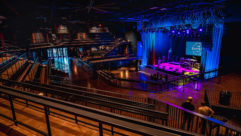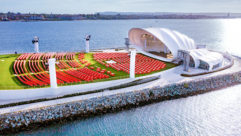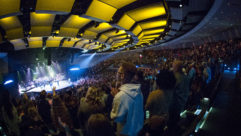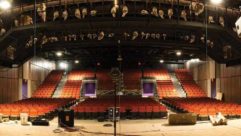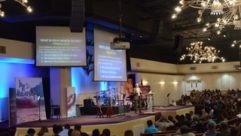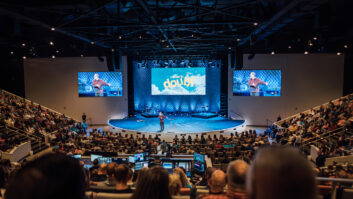Room Modeling: Is It Worth It?
We’ve all heard about sound system design disasters where the sonic performance of a system falls short of what’s adequate for the application.
We’ve all heard about sound system design disasters where the sonic performance of a system falls short of what’s adequate for the application. Engineers can determine if a bridge is strong enough before it’s built, or if an engine is powerful enough for the intended use of a motor vehicle. Why can’t we know in advance if a sound system will be loud enough and clear enough at all of the listener seats in an auditorium?
Sound system performance is highly room-dependent, so any effort made to know how a system will sound involves not only quantifying the loudspeaker’s response, but also predicting the acoustical behavior of the room in which it’s going to be installed.
Most sound system designers are familiar with room modeling programs. Some popular ones include EASE, CATT-Acoustic, Ulysses, Modeler, Odeon, LARA, and a few others. They all work basically the same way —the user constructs a virtual 3D model of the space, and then uses it to predict various aspects of the system’s performance.
What we need to know
The signature of how a room/system will sound is the impulse response (IR). The IR is the room’s response to a pulse of energy. A crude but effective IR measurement is to simply clap your hands and listen. The IR is unique for each source/listener position, so many IRs are required to characterize a space.
The IR is relatively easy to measure with high accuracy. A number of software/hardware tools exist to facilitate this. Room modeling programs attempt to predict the IR, which is not nearly so easy due to the many variables that influence it. A meaningful IR must contain information about the loudspeaker’s response as well as the level, direction, and spectral content of reflections from the room. Loudspeaker data is supplied by the manufacturers. A database of the acoustical properties of room surfaces is usually included with the modeling software.
What modeling programs don’t do well
No matter how much detail you try to put into a room model, you’ll never be able to exactly duplicate a measured impulse response. This is because the program is just a calculator, and it can only execute algorithms that have been programmed into it.
Wave propagation and wave interactions with room objects are well understood, but they’re amazingly complex. Even a simple room object has a very complex interaction with sound waves that encounter it. Short wavelengths (high frequencies) may reflect off of the object, while long wavelengths (low frequencies) may diffract around it. Medium wavelengths will do a bit of both. There’s no clear delineation between these various wave behaviors. So, even if you could model a room down to the finest detail, the prediction algorithms will fall short of producing the room’s exact response. The best that we can hope for is an estimate.
So, if a room modeling program can’t tell me what it will sound like, why bother using it at all? The modeling process is time consuming, and the learning curve on the software is quite steep. Plus, the prediction accuracy is governed by the user’s knowledge of room acoustics and electroacoustics. These issues keep some sound designers from modeling at all, instead relying on their intuition, experience, and some educated guessing. Is that good enough? Not always. Even the most experienced sound designer can’t consider the complex interactions between all of the system variables. These interactions produce surprises, and surprises can be expensive.
What modeling programs do well
Probably the most accurate of all predictions that these programs can do is loudspeaker coverage. This is good because loudspeaker coverage isn’t intuitive, and simply “hanging and pointing” will likely produce poor results. The sound radiation from a loudspeaker can be measured with high accuracy at a reference distance. The modeling program can extrapolate this response to the room boundaries using the inverse-square law. The result is a coverage map that shows the variation in the direct field levels produced by the loudspeaker across the audience.
The complex interaction of multiple sources can also be considered, which allows the performance of arrays to be assessed. It would be unconscionable to specify a sound system for a paying client without at least modeling the direct field coverage.
The second thing that modeling programs do well is to isolate the variables. Isolate means to be able to assess the change to one variable without affecting all of the others.
Both acousticians and sound system designers must make choices. Their intuition may tell them what may or may not work, and even narrow the choices to a few products. But sooner or later they must pick “A” or “B.”
As a sound system designer, if I could choose one capability to have as a tool of the trade, it would be the ability to instantly compare the relative difference between loudspeaker models and placements, along with the effect of various acoustical treatments.
The key words here are “relative” and “compare.” As long as my room model is reasonably accurate regarding geometry and surface coverings, I’m perfectly content knowing: “How much difference will it make if I change this to this?”
This is almost impossible to do in practice for several reasons. The first is that there’s a time lapse between the before and after. You can’t sit in a seat and listen to the room untreated, and then throw a switch and listen to it treated. The second is that to evaluate changes, you need to make the changes, and once you’ve made the change it’s often impractical to switch back to the original condition. We have to get it right the first time because we’re probably stuck with our first choice.
Only as good as you are
Some educated guessing will always be required to design sound systems. But the ability to evaluate the relative effects of our guessing is an invaluable tool. Room modeling, when combined with experience and knowledge, can allow performance predictions with reasonable accuracy to be made at the drawing board stage of a project.
Are they worth it?
Modeling programs are generally perceived to be expensive and time consuming. If you’re on the fence regarding their worth, consider the value of the following:
- Getting the right loudspeaker in the right place so that the coverage is even.
- Being certain that the thickness of the acoustic treatment on the back wall is adequate before it’s installed.
- Knowing with certainty that allowing the room treatment to be value engineered will result in poor speech intelligibility.
- Nailing the required power amplifier size at the drawing board to produce 95 dBA-slow at the back row.
No one would attempt to construct a building without a design. And no one would trust a building design to a novice.
Sound system designers owe it to their clients to possess the tools of the trade and become proficient at their use. With six-figure sound system budgets becoming more commonplace, the use of room modeling to qualify a design is no longer optional.
Pat Brown is president of Synergetic Audio Concepts (Syn-Aud-Con) Inc. and Electro-Acoustic Testing Company (ETC) Inc. Syn-Aud-Con conducts training seminars in audio and acoustics worldwide for those who operate, install, and design sound reinforcement systems. ETC Inc. performs precision loudspeaker testing for the audio industry. He can be reached at [email protected].


